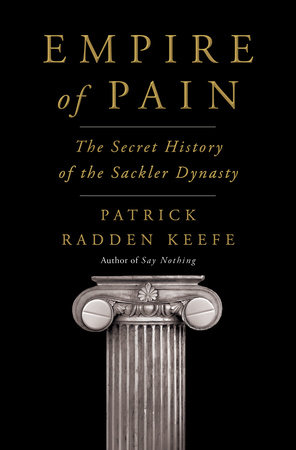I knew little about the Sacklers before starting Empire of Pain: The Secret History of the Sackler Dynasty by Patrick Radden Keefe. I had seen news about the protests at the Guggenheim, which bears the family name on its education center, and I knew they were connected with the company that produced OxyContin. But I didn’t understand the singular impact of OxyContin in the opioid crisis, nor of the family that went all-in on America’s addiction.
After reading Keefe’s Say Nothing: A True Story of Murder and Memory in Northern Ireland (which I reviewed here) and enjoying his podcast Winds of Change, it wasn’t a question for me whether I would pick up Empire of Pain. As in his previous work, Keefe is interested in memory—how individuals and communities process and respond to the events that define them. In the case of Empire of Pain, Keefe shines a light on the family’s rise, weaving a counter-narrative in dialogue with the family’s carefully-crafted public mythology.
Keefe is a master storyteller. As he threads together the experiences of the Sacklers and their victims, he illustrates how the Sacklers embodied the American dream gone wrong. After Isaac Sackler, the patriarch of the family, arrived in New York in 1904, he instilled in his three sons a strong work ethic and the importance of their good names. They proved successful, earning medical degrees and starting successful businesses. But soon Arthur, the eldest, launched ambitious corporate empire blurring the boundaries of the medical profession, pharmaceutical business, marketing industry, and government regulators, using his extensive influence in one area to bolster his investments in the others.
After Arthur’s death, his younger brothers expanded on the model through their company Purdue Pharma, and the next generation led it through the launch of OxyCodone, MSContin, and OxyContin. The central tenet of their business model was to get the prescription into the hands of as many patients as possible. Nothing was ever enough for them.
In the narrative, the Sacklers fill a dual role as protagonists and arch-villains. At times I found myself rooting for them; not wishing them success in their wrongdoings, but wishing they would show just a sliver of empathy and responsibility. None emerged, not even from the family members with a “socially-conscious” reputation. Instead, Keefe highlights the family’s hideous contempt of authority and truth. As far as the Sacklers are concerned, they are the victims.
While the degree of culpability varies between family members, their complete denial and lack of empathy suggests an almost hyperbolic villainy. Ordinarily, the sensationalism would seem base and tabloid, but Keefe backs up his assertions with the heavy weight of evidence, providing insight into the petty politics and gluttonous self-interest that drove the family to push harder and faster even as the damage became clear. They fired anyone in the organization who raised a red flag or even called for the company to do basic damage control in the interest of self-preservation, instead draining millions out of Purdue to line their own pockets.
Also of interest are the number of public figures employed by the family, including Rudy Giuliani and former U.S. attorney Mary Jo White. The Sacklers hired regulators, slandered victims, and pressured news outlets to muzzle their journalists. Their story is part of a broader narrative of money and power in twenty-first century America, corrupting institutions and reverberating across the nation.
There is no undoing the harm to lives and livelihoods for victims of the opioid epidemic. As Keefe explains, the legal system considers the matter a question of bankruptcy and restitution, and for various reasons the law is unlikely to punish the Sackler family for their wrongs.
Where justice falls short, Keefe sees a role for journalism in shaping the memory of these events. While the Sackler family was not solely responsible for the opioid epidemic, the book puts a face to the personal greed and institutional failings that created the broader crisis. For a family obsessed with their good name and reputation, Keefe’s work is a crushing indictment and a blistering embarrassment. Together with the artist Nan Goldin and other activists, Keefe has helped expose the Sacklers and isolate them from their enablers. In that sense, the book is not strictly neutral. Instead, like any good work of history, the book advances an argument, which the Sacklers are free to contradict. But to do that, they’ll need more than the feeble protestations of ignorance and naiveté they’ve offered so far.
There may never be true justice for the Sacklers, but Empire of Pain offers a thorough answer to the call for a public reckoning, as well as a warning to other would-be dynasties and the institutions beholden to them.
